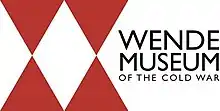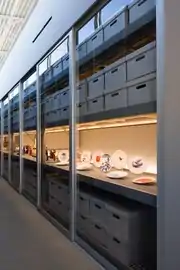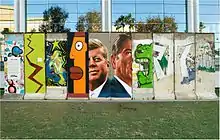Wende Museum
The Wende Museum of the Cold War is an art museum, historical archive, and educational institution in Culver City, California. It was founded in 2002 by Justinian Jampol,[1] a native of Los Angeles and scholar of modern European history. The museum was housed for more than a decade in an office park before moving in November 2017 to its current campus, a former National Guard Armory Building.[2]
 | |

| |
| Established | 2002 |
|---|---|
| Location | 10808 Culver Blvd, Culver City, CA 90230 |
| Type | Cultural Museum |
| Director | Justinian Jampol |
| Public transit access | Culver City Bus 3 and Metro Local bus 108 and 358 at Slauson Avenue/Buckingham Parkway |
| Website | www |

Name
Wende (pronounced “venda”) is a German word that translates into English as “transformation.” It commonly refers to the era of uncertainty and possibility leading up to and following the fall of the Berlin Wall in 1989 and the subsequent collapse of the Soviet Union in 1991.
Mission
The Wende Museum preserves Cold War history, inspiring a broad understanding of the period and exploring its enduring legacy. Named for the transformative period leading up to and following the fall of the Berlin Wall in 1989, the museum:
- collects and preserves artwork, artifacts, archives, films, and personal histories from Cold War era Eastern Europe and the Soviet Union;
- challenges and engages the public through experimental exhibitions and interdisciplinary programming inspired by the collection;
- promotes rigorous scholarship, educates students, and stimulates general interest through lectures, symposia, and publications; and
- illuminates the past and informs the present through creative collaborations with contemporary artists and designers.[3]
Collections
The Wende's collections are a resource for the vanishing cultural and political history of the former East Bloc countries (Albania, Bulgaria, Czechoslovakia, East Germany, Hungary, Poland, Romania) and the Soviet Union. The Wende uses cutting-edge museum and archival models to support emerging fields of academic study in visual and material culture studies as well as cultural history. The museum promotes a multi-layered exploration and discussion of the Cold War era.[4]
The comprehensive collection focuses on four areas:
- materials originating from East Germany, with more than 50% of the collection from the GDR;
- items used in everyday life and holdings capturing lived experience;
- materials that document "Wende Moments", or junctures in Cold War history marked by extreme change—beginnings, endings, and transformative events such as the formation of the Warsaw Pact, the fall of the Berlin Wall, German reunification, and the collapse of the Soviet Union; and
- official and unofficial artwork.[5]
The ever-increasing collection widely ranges from consumer products (e.g., computers, radios, records, toiletries, foodstuff) to works of art in all media (e.g., paintings, drawings, sculptures, graphics, photographs), iconic political symbols (e.g., statuary, medals, flags, uniforms, commemorative gifts), and archives — including a substantial gift from East German leader Erich Honecker's estate — and some 3,500 16mm documentary, animation, and educational films as well as home movies from the GDR.[6] The museum contains large collections of furniture, flags and banners, commemorative plates, Communist folk art, menus, family albums, and design items. The museum recently acquired a significant collection of Hungarian Cold War era artworks and artifacts[7] and Russian hippie materials from the 1960s and 1970s.[8]

In 2011, The Albanian Human Rights Project deposited its archive at the Wende Museum, which includes more than 70 filmed historical witness interviews with survivors of the Albanian communist purges, many of whom lived in prisons and forced labor camps for up to several decades.[9] The Wende Museum owns eleven original segments of the Berlin Wall, including ten pieces installed in front of 5900 Wilshire Boulevard, the longest stretch of the Wall outside Germany.[10] The eleventh, painted by Berlin-based artist Thierry Noir, stands in front of the museum's headquarters in Culver City.[11]
The museum's East German collections are the subject of a major Taschen publication, Beyond the Wall: Art and Artifacts from the GDR/ Jenseits der Mauer. Kunst und Alltagsgegenstände aus der DDR (Cologne: TASCHEN, 2014).[12] In 2019, Taschen published a smaller second edition of the book, The East German Handbook, featuring text in both English and German.[13]
The museum's collections have been exhibited, or are currently on display, in a number of other museums and institutions, including the Los Angeles County Museum of Art, Imperial War Museum (London),[14] Harry S. Truman Presidential Library and Museum (Independence, MO), Ronald Reagan Presidential Library (Simi Valley, CA), Gerald Ford Presidential Library (Ann Arbor, MI), the Goethe Institute (Washington, D.C.), the International Spy Museum (Washington, D.C.), the Neutra VDL Studio and Residences (Los Angeles),[15] the Getty Research Institute (Los Angeles),[16] and the El Segundo Museum of Art (El Segundo, CA).[17]
Programs
The museum’s public programming provides resources and opportunities for individuals to interpret the past and to discover the global implications of the Cold War today. The museum uses the Cold War as a lens to examine contemporary life and creative expression, and to draw parallels between the past and the present day.

The Wall Project
In 2009, the Wende Museum commemorated the 20th anniversary of the fall of the Berlin Wall with The Wall Project, the most ambitious commemoration outside of Germany. As part of the event, the museum installed ten original segments of the Berlin Wall in front of 5900 Wilshire Boulevard. It is the longest stretch of the Berlin Wall in the United States.[18] As part of the project, four artists including Los Angeles-based muralist Kent Twitchell and Berlin-based artist Thierry Noir, were invited to paint segments of the wall. On the night of November 8, 2009, a temporary replica of the wall painted by Shepard Fairey, graffiti artists working with ArtStorm, and the general public titled "The Wall Across Wilshire" closed down Wilshire Boulevard, dividing Los Angeles into East and West.[19]
Other ongoing programs include Music at the Wende, the Historical Witness Project, Friday-Night Films at the Wende, and Wende Conversations: A Discussion Series Supported by Susan Horowitz and Rick Feldman.
Highlighted exhibitions


Across/ The Wall was organized in conjunction with the Downtown Los Angeles Art Walk in 2011. The exhibition featured 21 high-resolution reproductions of Soviet era portraits exhibited on the exterior wall of a parking garage.
Deconstructing Perestroika (January 28 - May 6, 2012) was organized in collaboration with the Craft and Folk Art Museum in Los Angeles. The exhibition featured 24 original, hand-painted poster designs by 13 artists in response to Mikhail Gorbachev's transformative policies of Glasnost and Perestroika in the late 1980s.[20] In 2013, the exhibit traveled to the Natalie and James Thompson Art Gallery at San Jose State University.
Competing Utopias was organized in collaboration with the Neutra VDL Studio and Residences from July 13 to September 13, 2014. The exhibition was an experimental installation of East German modernist interior design objects from the Wende Museum’s collection within the VDL Research House, an iconic mid-century example of California architecture by Austrian-American architect Richard Neutra.[21][22] Face to Face (June 12, 2015 - September 18, 2015) featured a broad selection of painted and photographed portraits from the Soviet Union, Cold War era Hungary and East Germany, highlighting the diversity within socialist Eastern Europe.[23]
Cold War Spaces (November 19, 2017 - April 29, 2018) was the museum's inaugural exhibition at the Armory site. The exhibition explored Cold War era Eastern Europe and the Soviet Union through the physical and ideological spatial relations and divisions of the time.[24][25]
War of Nerves: Psychological Landscapes of the Cold War (September 20 - January 13, 2019) was organized in collaboration with the Wellcome Collection (London). The exhibition looked at the Cold War as “a war of the mind”, exploring the mutual suspicion, fear and mistrust between the Soviet Bloc and the West.[26]
Upside-Down Propaganda: The Art of North Korean Defector Sun Mu (February 10 - June 2, 2019) was the first U.S. museum exhibition of North Korean dissident artist Sun Mu. The exhibition featured paintings in the style of propaganda posters that satirically portrayed the politics of North Korea.[27][28]

Site
In November 2012, the City Council of Culver City voted unanimously to approve a 75-year lease of the former United States National Guard Armory building in Culver City as the permanent location of the Wende Museum.[29][30] The Armory building was originally constructed by the National Guard in 1949 as the Cold War began to escalate, and was decommissioned in March 2011. Following renovations, the Wende Museum opened to the public at the Armory site in November 2017.[31] The one-acre campus is designed in a spirit of transparency and open access to Cold War secrets.[32]
References
- "The Cold War as a museum: At the Wende, one man's 100,000-piece collection finds a new home". Los Angeles Times. 2017-11-16. Retrieved 2019-10-29.
- Barragan, Bianca (2017-09-08). "Culver City's Cold War-focused Wende Museum to reopen in November in revamped National Guard Armory". Curbed LA. Retrieved 2019-10-29.
- "About Us | Wende Museum". www.wendemuseum.org. Retrieved 2019-10-29.
- The Atlantic "Cold War Relics: The Wende Museum Saves Communist Design"
- "Our Collections | Wende Museum". www.wendemuseum.org. Retrieved 2019-10-29.
- Heller, Steven (2011-08-11). "Cold War Relics: The Wende Museum Saves Communist Design". The Atlantic. Retrieved 2019-10-29.
- Kahn, Eve M. (2016-01-07). "A Surge of Interest in East-Bloc Mementos". The New York Times. ISSN 0362-4331. Retrieved 2019-10-29.
- The Wall Street Journal - An Auction for Budapest's Bourgeoisie Puts Lenin on the Communist Block - WSJ.com
- "Albanian Human Rights Project (AHRP) - U.S.-based, non-profit". ahrp. Retrieved 2019-10-29.
- "Wall-to-wall unity symbol". Los Angeles Times. 2009-08-12. Retrieved 2019-10-29.
- "Berlin Wall rebuilt in Los Angeles". www.thelocal.de. 2009-11-02. Retrieved 2019-10-29.
- Welch, David (2014-12-05). "'DDR Posters' and 'Beyond the Wall'". The New York Times. ISSN 0362-4331. Retrieved 2019-10-29.
- Staff, C. N. N. (2018-01-10). "Striking vintage designs from behind the Iron Curtain". CNN Style. Retrieved 2019-10-29.
- Addley, Esther (2019-10-04). "Repainting the Berlin Wall as timely reminder to a new generation". The Guardian. ISSN 0261-3077. Retrieved 2019-10-29.
- Jao, Carren (2014-07-09). "Where the Curtains Were Made of Iron". The New York Times. ISSN 0362-4331. Retrieved 2019-10-29.
- "The Getty Research Institute". Getty Research Institute. Retrieved 2019-11-01.
- Easy Reader News - Here Today, Gone Tomorrow-"Fame" in El Segundo, explores the renowned and the forgotten in a new exhibition
- "Preserving the Cold War in Sunny California". Public Radio International. Retrieved 2019-10-30.
- "When the wall tumbled down". Los Angeles Times. 2009-11-06. Retrieved 2019-10-30.
- "Poster art exhibit recalls end of Soviet era". Los Angeles Times. 2012-02-19. Retrieved 2019-10-30.
- "West Coast meets Eastern Bloc in 'Competing Utopias' exhibition". Los Angeles Times. 2014-07-10. Retrieved 2019-10-30.
- "L.A. Designer: A "Collective" Creates "Competing Utopias"". KCRW. 2014-07-09. Retrieved 2019-10-30.
- Ivanov, Oleg. "The Ideology of the Everyday: The Wende Museum's "Face to Face" Exhibition". Los Angeles Review of Books. Retrieved 2019-11-01.
- "The Newly Expanded Wende Museum Offers a Nuanced Perspective on the Cold War". Hyperallergic. 2018-04-11. Retrieved 2019-11-01.
- "Cold War Spaces at the Wende Museum". www.laacollective.org. Retrieved 2019-11-01.
- Dambrot, Shana Nys (2018-11-06). "The Wende Museum Explores the Art of, and Resistance to, Cold War Brainwashing". LA Weekly. Retrieved 2019-11-01.
- Stuart, Gwynedd (2019-03-05). "North Korean Defector Sun Mu Is Turning Propaganda Art on Its Head". Los Angeles Magazine. Retrieved 2019-11-01.
- Tiven, Lucy (2019-02-21). "North Korean Defector Artist Sun Mu's Lost Utopias". Garage. Retrieved 2019-11-01.
- "Culver City's Cold War museum is hoping for a victory". Los Angeles Times. 2012-11-11. Retrieved 2019-10-29.
- "Culver City approves Cold War museum's lease for new home". LA Times Blogs - L.A. NOW. 2012-11-14. Retrieved 2019-10-29.
- "The Cold War as a museum: At the Wende, one man's 100,000-piece collection finds a new home". Los Angeles Times. 2017-11-16. Retrieved 2019-10-29.
- Donath, Jessica (2017-11-13). "Inside a 1940s Armory in Culver City, a Museum Sheds Light on the Cold War". LA Weekly. Retrieved 2019-10-29.
External links
| Wikimedia Commons has media related to Wende Museum. |